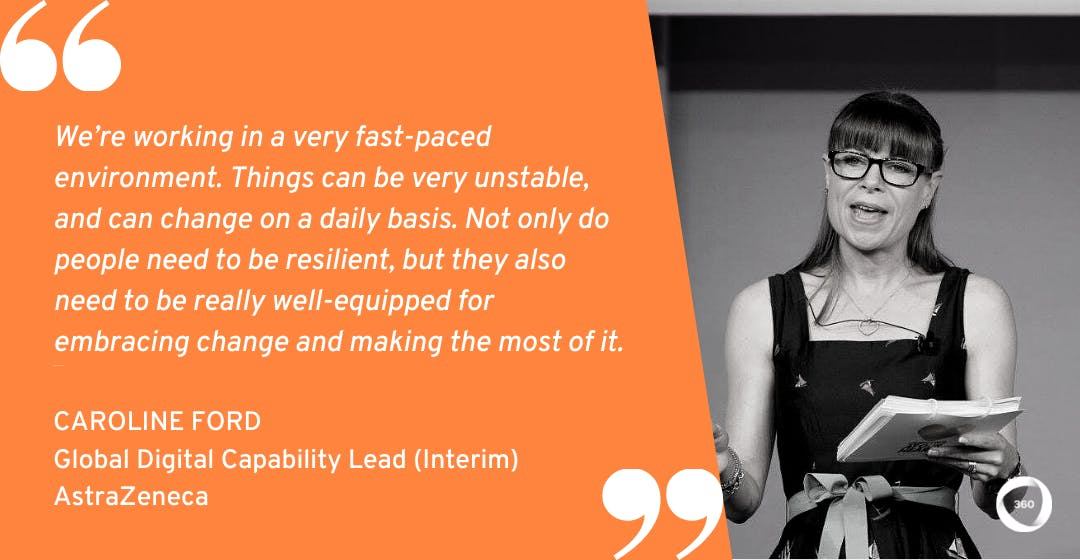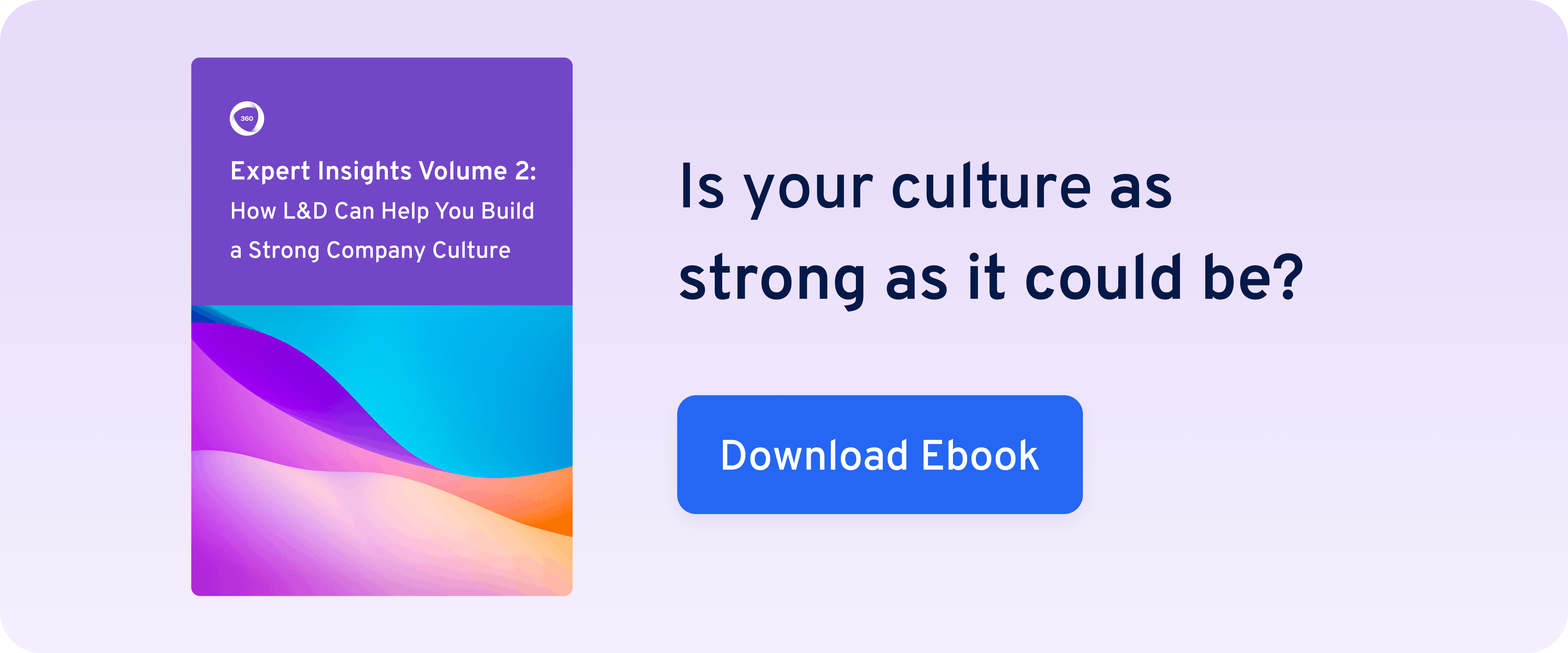Every L&D team is focused on staying ahead of the next big trends. As learning leaders, it’s our job to design training experiences that help people build new capabilities in emerging technologies.
But what about one of the biggest names in biopharmaceuticals? How does a company like AstraZeneca design learning experiences to ensure every one of its teams stays on top of the newest digital trends and technologies?
Recently, I spoke with Caroline Ford, AstraZeneca’s Interim Global Digital Capability Lead, about her four-step playbook for building new digital capabilities. From building a shared vocabulary to engaging end users, Caroline showed me how AstraZeneca stays current.
Read on to find out more about AstraZeneca’s collaborative playbook for digital learning.
Psst: You’re reading the 50th episode of CLO Connect! Stay tuned for next week’s big celebration.
The 3 major digital L&D challenges AstraZeneca faces today
As one of the biggest names in biopharmaceuticals, AstraZeneca needs no introduction. During the COVID-19 pandemic and the global recovery, they’ve become a household name. As Caroline explains, this pandemic has created a new urgency for digital capability learning.
“The pandemic more than anything has accelerated the need for immense digital capability across all areas of every business,” says Caroline. “AstraZeneca is no exception to this. The challenges we’re experiencing are very similar to other organizations and other industries.”
The first of these challenges? Speaking the same language about digital technologies.
Challenge #1: Ensuring a shared digital vocabulary
“Some of the key things we’ve seen coming through our learning research is a need for clarity and understanding around what digital really means,” says Caroline. “You can ask ten different people in ten different functions, and each person will give you a slightly different definition of what digital means to them.”
“When you’re looking at one particular topic area like digital data and analytics as a collective, it’s really important to help people step forward with a single shared understanding and a single lexicon. This helps everyone to start from a similar starting point.”
Challenge #2: Building digital awareness and adaptability
Once you’ve got a shared vocabulary, the next challenge is to build generalist digital capability. “People are looking not just at the nitty-gritty specialist data analysis, but the skills that our broader general employees need to excel in our organization. These are things like a basic awareness of data science and AI.”
“We don’t need everyone to be a deep specialist, but we do need people to know about the major trends that are coming down the line, and which are likely to affect them in their role. For example, how might automation play a role in our industry now and in the future?”
“We’re working in a very fast-paced environment. Things can be very unstable, and can change on a daily basis. Not only do people need to be resilient, but they also need to be really well-equipped for embracing change and making the most of it.”

Challenge #3: Helping people to use design thinking, lean, and agile methodologies
“Finally, there’s a trio of skills that aren’t strictly about digital technologies and digitization, but they’re closely related. These are design thinking, lean, and agile ways of working.”
“In the past these would have been attributed to product design, manufacturing, or IT. But now these capabilities are prized by the majority of organizations and applied across the majority of functions.”
So, how is AstraZeneca responding to these learning challenges?
You can never have enough expert insights! Check out our ebook to find out How L&D Can Help You Build a Strong Company Culture
AstraZeneca’s 4-step learning playbook to build digital capability
As Caroline explains, AstraZeneca is using a four-step learning playbook to build digital capability. Here’s how she breaks it down.
Step #1: Research your end users thoroughly
“First and foremost, we start with an end-user mindset,” says Caroline. “Whether you’re developing a product for learning or for any other element of your business or customer experience, that’s where you have to start.”
“We began with deep-dive research looking at 200 colleagues across the organization. We found a good range of business areas, geographies, horizontals, and verticals.”
For Caroline, it was important to make this research representative. “We worked predominantly with our senior stakeholders, which was our digital capability steering committee. We also spoke to middle managers from a wide range of areas, as well as individual employees who were representative of our general population.”
“We also got some help from our communications team in building out a set of personas that helped us reach into our community and identify the right people to get involved in the research. This helped us to focus our activities on the right people.”
Step #2: Identify the key capabilities you need to address
Next up, Caroline and her team had to identify the key capabilities they wanted to address.
“We had to find the pain points that rose to the surface,” she says. “These included digital leadership, and basic digital foundations, like understanding the rhythm of how new products or digitization tools actually work, be it in organizations or in the general population at large.”
“Once we’d identified these trends and our senior leadership had signed off on them, we needed to find subject-matter experts to help us build the training.”
Step #3: Invite subject-matter experts to build your training
“You need to find people by reputation,” says Caroline. “So, we took our subject areas, and anyone who consistently came up as being an expert we needed to talk to, we reached out and asked them to build the product. These people were only too willing to help.”
Finally, with the draft training in place, it was time to test and iterate.
Step #4: Engage a user group of volunteers to test and iterate
“Once we had developed our draft training program with subject-matter input, we engaged a user group of volunteers. We had 75 colleagues from across our many geographies and working areas coming in regularly to help us shape, test, and learn iteratively as we built out the digital capability training.”
But how exactly did Caroline make sure this new digital capability training was truly collaborative?
Related: Experts Engagement Tool: Leverage Subject-Matter Expertise With Collaborative Learning
We had to find the pain points that rose to the surface. These included digital leadership, and basic digital foundations, like understanding the rhythm of how new products or digitization tools actually work.
How to build collaboration with education, exposure, and experience
As Caroline explains, AstraZeneca’s new training wasn’t just about theory–she also needed learners to put their knowledge into practice.
“We have a methodology which is built on the premise of education, exposure, and experience,” she says. “We have our online education platform, but we also support that with virtual classroom training, or in-person training in normal circumstances.”
“We then have an exposure piece, where we connect people who might not otherwise come into contact with each other on a day-to-day basis. We’ve done this by creating communities of practice, or where these communities already existed, raising awareness of them and making sure they’re visible.”
Finally came the focus on experience. “We want to create opportunities for people to learn on the job and try out these new skills and activities for themselves. That’s how we know they’re actually building real-time capability in the real world by solving real problems.”
Related: 5 Learning Organization Examples to Inspire Your Company
We want to create opportunities for people to learn on the job and try out these new skills and activities for themselves. That’s how we know they’re actually building real-time capability in the real world by solving real problems.
The impact of AstraZeneca’s digital capability playbook
So, what impact has this new digital capability playbook made so far?
“It’s early days, but we’re really pleased with some of the results we’re seeing,” says Caroline. “For example, we’ve seen great uptake in our product suite, with people using the product quite innovatively. We want our professionals to take up these learning assets and recombine the elements of these learning pathways in their own business areas and areas of specialization.”
Caroline had a great example of this innovation in practice. “One of our learning teams in our commercial area has created a skills matrix and capability framework using the foundational elements of our digital awareness hub. This is designed to help build digital capabilities at the entry level for new joiners. It’s a great example of how they’re applying assets into new areas.”
Related: 3 Data-Based Ways to Prove Training ROI (+ Free Training ROI Calculator)
We want our professionals to take up these learning assets and recombine the elements of these learning pathways in their own business areas and areas of specialization.
We’d like to note that Caroline recently completed her interim contract with AstraZeneca. Thanks again to Caroline for taking the time to chat about this exciting initiative!
And if you’re looking for more expert insights about employee training, check out my interviews with Areebah Ajani of Qualtrics about using a diagnostic tool to set development priorities, and with Joshua Clark of Cisco about empowering employees to navigate career opportunities.
Want more peer insights on transforming workplace learning? Check out #CLOConnect, our interview series with top L&D leaders on driving growth and scaling culture through Collaborative Learning. Or you can subscribe (below 👇) to our weekly newsletter to receive our latest posts directly in your inbox.



